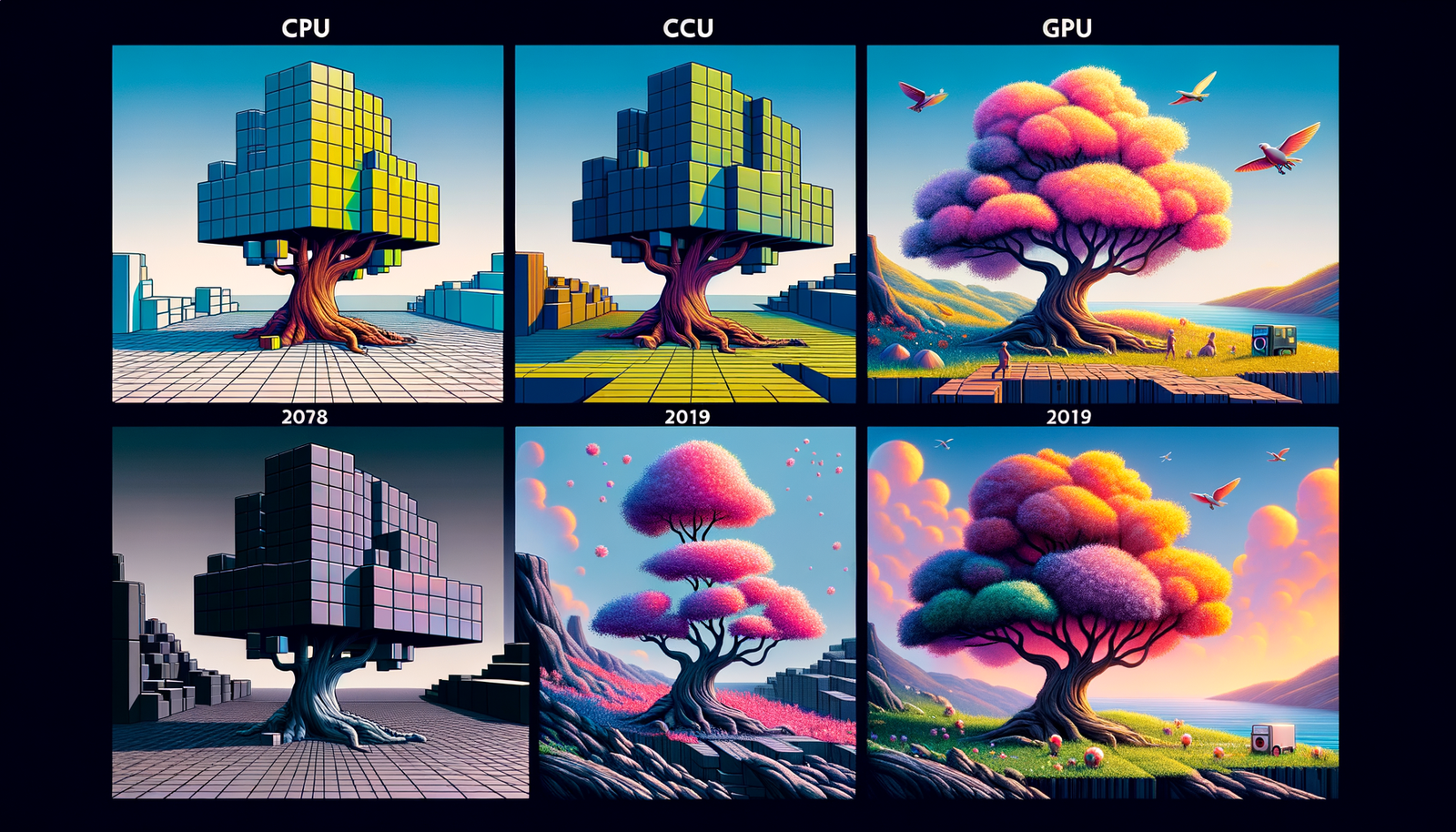Your Cart is Empty
Customer Testimonials
-
"Great customer service. The folks at Novedge were super helpful in navigating a somewhat complicated order including software upgrades and serial numbers in various stages of inactivity. They were friendly and helpful throughout the process.."
Ruben Ruckmark
"Quick & very helpful. We have been using Novedge for years and are very happy with their quick service when we need to make a purchase and excellent support resolving any issues."
Will Woodson
"Scott is the best. He reminds me about subscriptions dates, guides me in the correct direction for updates. He always responds promptly to me. He is literally the reason I continue to work with Novedge and will do so in the future."
Edward Mchugh
"Calvin Lok is “the man”. After my purchase of Sketchup 2021, he called me and provided step-by-step instructions to ease me through difficulties I was having with the setup of my new software."
Mike Borzage
The Evolution of Rendering: From CPU Constraints to GPU-Driven Realism
December 06, 2024 6 min read


The field of rendering has undergone significant transformation over the years, driven by technological advancements and the relentless pursuit of more realistic and efficient visualizations. As the demand for high-quality graphics in various industries continues to grow, understanding the evolution of rendering techniques becomes essential. This exploration delves into the journey from traditional CPU-based methods to the current state of GPU acceleration, highlighting the catalysts for change and the breakthroughs that have reshaped the rendering landscape.
Historical Overview of Rendering Techniques
In the early days of computer graphics, rendering was predominantly handled by central processing units (CPUs). These traditional CPU-based rendering methods relied on sequential processing, which, while effective for simpler tasks, posed significant challenges when dealing with complex scenes and high-resolution images. The limitations of CPU rendering became increasingly apparent as the demand for more detailed and realistic images grew. Long rendering times were common, often hindering the creative process and stretching project timelines. This was particularly evident in industries such as animation and architectural visualization, where rendering a single frame could take hours or even days.
The challenges faced by early rendering techniques were multifaceted. Firstly, CPUs, designed for general-purpose computing, lacked the specialized architecture needed for the highly parallelizable tasks inherent in rendering. Secondly, the computational power required to simulate lighting, shadows, reflections, and other sophisticated effects surpassed what CPUs could efficiently deliver. These limitations prompted the industry to seek alternative solutions that could meet the increasing performance demands.
The transition to GPU acceleration was a pivotal shift in the rendering paradigm. Graphics processing units (GPUs), initially developed to accelerate memory-intensive tasks in computer graphics, offered a promising solution. The GPU's ability to handle multiple operations simultaneously made it ideal for the parallel processing required in rendering complex scenes. This shift was prompted by the need for faster rendering times and the pursuit of higher fidelity visuals, leading to a reevaluation of traditional rendering pipelines and the integration of GPU technology.
Understanding GPU Acceleration
At the core of GPU acceleration lies the unique architecture of GPUs, which contrasts significantly with that of CPUs. GPUs are designed with a multitude of smaller, efficient cores that can perform parallel operations on large blocks of data. This parallel processing capability allows GPUs to handle thousands of threads simultaneously, making them exceptionally well-suited for rendering tasks where multiple pixels and vertices can be processed in parallel. In contrast, CPUs typically have fewer cores optimized for sequential serial processing, which limits their efficiency in handling the parallel nature of rendering calculations.
When comparing CPU and GPU processing in rendering tasks, the advantages of GPUs become evident. While CPUs excel in tasks requiring complex logic and linear processing, GPUs outperform when it comes to handling repetitive calculations across vast datasets, such as those involved in image rendering. GPUs can accelerate the rendering pipeline by offloading computationally intensive tasks like shading, texture mapping, and geometric transformations. This offloading not only speeds up the rendering process but also frees up CPU resources for other tasks, enhancing overall system performance.
The key benefits of using GPU acceleration in rendering are manifold:
- Speed Enhancement: GPUs dramatically reduce rendering times from hours to minutes or even enable real-time rendering.
- Efficiency: GPUs optimize resource utilization, enabling higher quality renders without proportionally increasing hardware requirements.
- Cost Savings: Reducing the need for large render farms and associated energy consumption can lead to significant savings.
These benefits facilitate more iterative design workflows, allowing artists and designers to see immediate results and make real-time adjustments, which is invaluable in the fast-paced environments of modern creative industries.
Advancements in Rendering Quality
GPU acceleration has not only increased rendering speed but has also significantly enhanced rendering quality and realism. By leveraging the massive parallel processing power of GPUs, rendering engines can perform more complex calculations that simulate physical lighting and shading with greater accuracy. Techniques such as real-time global illumination, advanced particle effects, and high-resolution texture mapping are now more accessible, resulting in visuals that are strikingly realistic. This improvement in quality is crucial for industries that rely on visual fidelity, where the difference between a good render and a photorealistic one can have substantial impacts.
Several software solutions have emerged to harness the capabilities of GPUs for improved visual results. Applications like NVIDIA's Iray, Autodesk's Arnold GPU, and Lumion have integrated GPU acceleration to offer users enhanced performance and quality. These programs utilize the GPU to compute complex rendering algorithms efficiently, providing users with faster feedback and higher quality outputs. The integration of GPU acceleration in these tools has democratized access to high-end rendering capabilities, enabling professionals and enthusiasts alike to produce images and animations of exceptional quality.
The impact of real-time rendering on industries such as gaming, film, and product design cannot be overstated. In gaming, GPU acceleration has enabled developers to create immersive and visually stunning worlds that render in real-time, enhancing the player experience. In the film industry, the ability to render high-quality visual effects quickly has streamlined production workflows and opened new creative possibilities. For product design, real-time rendering allows designers to visualize prototypes with lifelike materials and lighting conditions, aiding in decision-making processes and client presentations. These advancements have reshaped expectations and set new standards for visual content across various sectors.
Challenges and Future Directions
Despite the significant benefits, GPU acceleration in rendering is not without its challenges. One of the current limitations is the dependency on hardware compatibility and the need for continuous hardware upgrades to keep up with software advancements. As rendering algorithms become more sophisticated, they demand more from the GPU, which can be a barrier for individuals and organizations with limited resources. Additionally, GPUs are traditionally optimized for specific types of parallel computations, and rendering complex scenes with intricate details can still pose performance issues.
Anticipated technological advancements hold the promise of addressing these limitations and further enhancing GPU-accelerated rendering. Developments in GPU technology, such as increased memory capacity, improved processing power, and advancements in ray tracing capabilities, are expected to push the boundaries of what's possible. Manufacturers are focusing on creating GPUs that are more efficient and capable of handling increasingly complex rendering tasks. The advent of cloud-based GPU rendering services also offers a scalable solution, providing access to high-end GPUs without significant upfront investment.
The role of AI and machine learning in future GPU-accelerated rendering solutions is poised to be transformative. AI algorithms can optimize rendering processes by predicting lighting and shading patterns, reducing the computational load required for high-quality renders. Machine learning techniques can be used to denoise images, upscale resolutions, and even generate textures and assets procedurally. Integrating AI into GPU rendering pipelines can significantly enhance performance and quality, enabling real-time rendering of scenes that were previously too complex.
Conclusion
The evolution of GPU acceleration has had a transformative impact on rendering speed and quality. Moving from traditional CPU-based methods to leveraging the parallel processing power of GPUs has revolutionized how visuals are created and experienced. This shift has enabled faster rendering times, higher quality outputs, and has opened up new possibilities in various industries. The integration of GPU acceleration into rendering workflows has not only improved efficiency but has also expanded creative horizons.
These developments influence broader design workflows by facilitating more iterative and explorative processes. Designers and artists can now experiment with ideas more freely, receiving instant feedback and refining their work without the time constraints imposed by lengthy rendering times. The enhanced capacity to visualize concepts in real-time improves collaboration, decision-making, and ultimately leads to better outcomes. The seamless integration of rendering into the design process is reshaping how projects are conceptualized and executed.
Looking ahead, the continuing evolution of GPU acceleration is set to play a significant role in upcoming design trends. As technology advances, we can expect even greater integration of GPU capabilities, further blurring the lines between real and virtual. The incorporation of AI and machine learning will likely amplify these effects, introducing new tools and methods that redefine rendering and design. The ongoing advancements in GPU technology are not just improvements in hardware but are catalysts for innovation across multiple disciplines, heralding a future where rendering is faster, more efficient, and incredibly lifelike.
Also in Design News

Cinema 4D Tip: Optimizing Collision Deformer for Realistic Surface Interactions in Cinema 4D
October 18, 2025 3 min read
Read More
Bluebeam Tip: Optimizing Field Data Collection with Bluebeam Field Tools
October 18, 2025 2 min read
Read More
V-Ray Tip: Optimizing Realistic Glass Material Rendering in V-Ray
October 18, 2025 2 min read
Read MoreSubscribe
Sign up to get the latest on sales, new releases and more …


